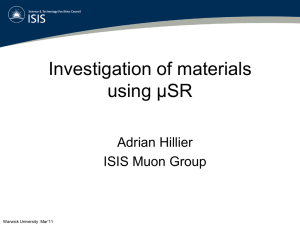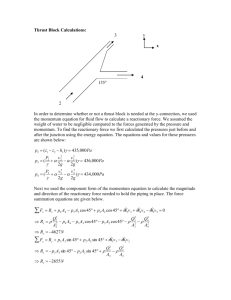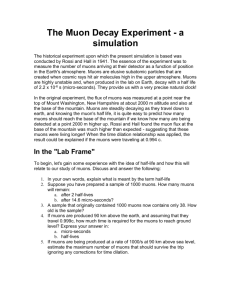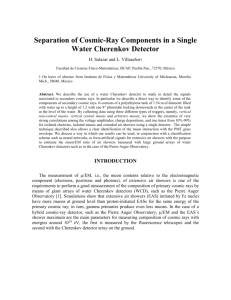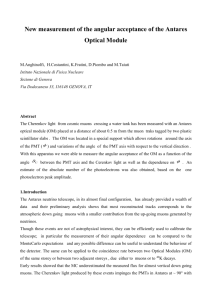Exercise5
advertisement
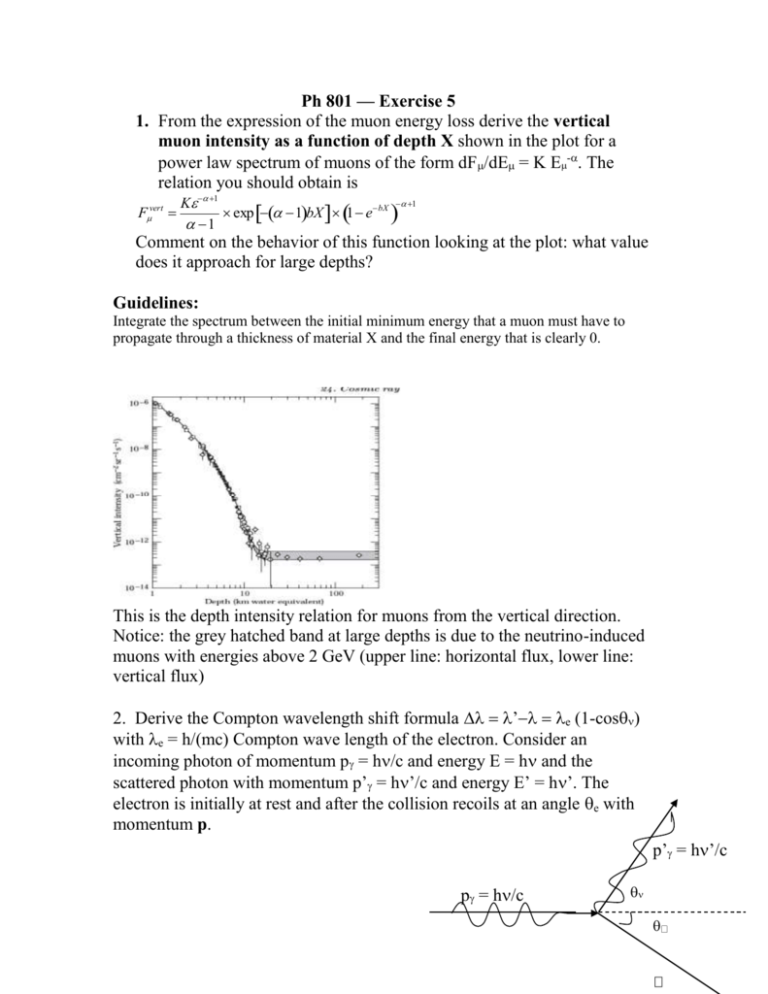
Ph 801 — Exercise 5 1. From the expression of the muon energy loss derive the vertical muon intensity as a function of depth X shown in the plot for a power law spectrum of muons of the form dF/dE = K E-. The relation you should obtain is Fvert 1 K 1 exp 1bX 1 ebX 1 Comment on the behavior of this function looking at the plot: what value does it approach for large depths? Guidelines: Integrate the spectrum between the initial minimum energy that a muon must have to propagate through a thickness of material X and the final energy that is clearly 0. This is the depth intensity relation for muons from the vertical direction. Notice: the grey hatched band at large depths is due to the neutrino-induced muons with energies above 2 GeV (upper line: horizontal flux, lower line: vertical flux) 2. Derive the Compton wavelength shift formula ’e (1-cos) with e = h/(mc) Compton wave length of the electron. Consider an incoming photon of momentum p = h/c and energy E = h and the scattered photon with momentum p’ = h’/c and energy E’ = h’. The electron is initially at rest and after the collision recoils at an angle e with momentum p. p’ = h’/c p = h/c Suggested solution 1. The minimum energy E of a muon to penetrate at depth X before it stops can be calculated in the following way: dE 0 E ,min dE 1 1 b (a bE ) X ln 1 E ,min E ,min dE / dx 0 dx a bE b a a bE ,min E ,min E ,min a bX bX log E ,min e bX 1 log e b a 2 For small column depths X<<1/b 1/4e-6 g/cm = 2.5 kmwe muons lose energy mostly on ionization and E,minbX = aX. The muon energy spectrum underground then reflects the surface muon spectrum. 0 dF 0 1 K K K 1 bX 1 KE Fvert K E dE E 1 E E ,min e 1 ,min dE 1 1 1 E ,min 1 K 1 ebX e bX ebX 1 ebX 1 K 1 1 ebX 1 ebX 1 K 1 1bX e 1 ebX 1 This is the flux of muons that survives after propagating a depth X in the vertical direction. The first term is a constant term with depth and reflects the muon energy spectrum at surface. The 3rd term is always larger than 1 and approaches 1 at large depths. At large depths the second term determines the depth intensity curve which has the exponential shape exp(-X/X0) with X0 = [b(-1)]-1. For inclined directions the absorbing ground layer increases like 1/cos = sec ( = zenith angle) for a flat overburden, so that for muons from inclined directions the depthintensity relation exponential term is modified as e-(-1)bsecX. 2. Energy conservation: h mc 2 h ' p2c 2 m 2c 4 h 'K e mc 2 K e h( ') Momentum conservation p = p + p’ h 2 h ' 2 h h ' h 2 ' 2 cos 2 cos p2 cos2 e cos pcos e c c c c h 2 h ' 2 h 2 ' c2 2 2 cos p2 p2c 2 h 2 ( 2 '2 ) 2h 2 'cos c c c h ' sin psin h ' 2 2 2 e sin p sin e c c h 2 ( ') 2 m 2c 4 2mc 2 h( ') p 2c 2 m 2c 4 h( 2 '2 ) m 2c 4 h 2 '2mc 2 h( ') 2h 2 'cos mc 2 ( ') h '(1 cos ) 1 1 h h (1 cos ) ' (1 cos ) e (1 cos ) 2 ' ' mc mc c




